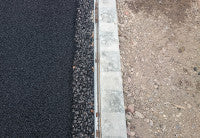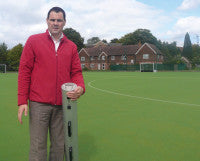Refurbishing existing surfaces

Life Cycle Planning
The refurbishment of an existing facility affords a real opportunity to revisit the design in context of any up to date requirements, governing body recommendations and current thinking. It is also the time when you find out how good the build was first time round. Most of the governing bodies would recommend that a sinking fund is put in place when purchasing a new synthetic or all weather facility to refurbish or replace it after a given period of time. Typically, ten years is mentioned, certainly for resurfacing works, but this can extend significantly with a sound maintenance plan in place.
Nowadays, there is a lot more joined up thinking regarding this and people see the benefits of maintenance from day one as it can really extend the life span of a surface to fifteen years or beyond.

An annual sinking fund, whereby a small portion of money is saved every year, should help cover the cost of replacement and is particularly important in businesses where cash flow and finances are tight. Private sports clubs these days do not have large residual reserves of cash and need to plan in the long term for updating and upgrading facilities. As you will know, sports governing bodies are a useful source of advice and funding for when this sort of work is planned, however there can be conditions to the funding that may prove onerous or may render you unsuccessful in any funding application.

When considering replacement funds needed, it is worthwhile seeking some independent objective advice as to the sort of costs that may be involved in any refurbishment or replacement process. This will give you a good angle on the actual monies needed. There have been instances that I have come across where clients have approached the market for costs but, depending upon who you speak to, there can be significant variation in budget estimates and in proposed design solutions and options.
It is also worthwhile remembering that, when replenishment or refurbishment comes along, it does afford you an opportunity to upgrade facilities as well as simply replace them. This means that budgets may change and need to reflect the constant improvement that we have in both materials and functionality of our sporting landscapes. I would always advise a client to make some provision for this within any projections of future finances needed.
Costs and Budgeting

As clubs and schools etc. evolve, so the requirements of the end user may change as well, and it is worthwhile sitting down with project team members to discuss future requirements. In my previous articles, I mention storage areas, warm up areas and detox facilities etc. which should be considered in any new design.
Once the full requirements of the site are known and a detailed site investigation carried out, then an objective rough order budget can be put together for the replenishment works. This may be the trigger for funding applications etc., so plenty of time should be allowed to carry out this process and put together any finances required. I have known this to take a couple of years.
Once a rough order budget has been agreed, then a more detailed design solution can be drawn up and, potentially, the works tendered. This will allow you to obtain current market prices for the remedial works and start to programme and plan health and safety etc. Additional costs, such as external fees, sometimes VAT and contingencies should all be planned within the budget.

During the project works itself, a monthly cash flow forecast should be obtained from the successful contractor so that the client has a good angle on what funds will be required and when, and the terms on which the monies will need to be paid. This is particularly important when seeking funds from external bodies as there very often can be a delay in payment from the main funding authority to the client and, in turn, to the contractor. It is best that this is known about up front and discussed with the contractor at the time of appointment. Many contractors are happy to work with this as long as they know about it.
Project Programming
It is often surprising how long a refurbishment project can take to plan. The consequences of poor programming can be disastrous and each individual organisation will have to decide what time of year is best for the work to be carried out in context of any engineering requirements and climatic conditions.
Typically, the warmer spring, summer and autumn months are best for refurbishment work as materials and techniques employed need a kinder climate in order to be installed successfully, and certainly be implemented. I would always advise planning a project the year before the works are to be executed, but realise that this is not always possible.
Recently, we refurbished a synthetic pitch from conception and agreement to completion in four months. This was a significant project and only commissioned because we had the experience and expertise to be able to advise the client that it was feasible. This strategy, however, is not without risk and you are reliant on other factors falling into place in order to deliver success. So our advice with this is be careful and give yourself as much time as possible to plan the project.
As discussed below, there may well be additional considerations such as finances and planning which will require more time. With the recent health and safety CDM changes, a period of time is also required for sound design solution evaluation and health and safety planning.
Also, experience of carrying out such works can allow you to offer good guidance to clients as to the exact programme that will be required to execute the contract, and it is worth verifying this at tender stage with the contractors selected to tender. This is normally done via the form of tender.
Once a programme is developed, it can slot into the overall site calendar and be dovetailed with other works taking place, which is not at all uncommon, especially on school sites in the summer months. Appropriate site signage and marketing and PR information can then be distributed to interested parties so that the programme starts and is run on a positive basis. Regular project meetings throughout the programme can constantly check on project progress in light of the programme itself and any variations from this can quickly be resolved to deliver the project on time and on budget.
Design Improvements

In marketing terms, an upgraded facility can provide real impetus and enthusiasm across a site for existing users and also provide a facility to attract new clients. We have been to many facility handovers over the years and there is a real excitement about a new project and its use across the client group. This is particularly enhanced if the facility is opened and documented via local media etc.
When renovating or refurbishing, you have a real opportunity to upgrade the facilities and implement new surface technology or enhance layouts and accessibility. Sometimes, this is carried out in tandem with the installation of additional facilities, such as changing rooms, clubhouses etc., but we tend to focus on the sports facility provision side of things. Surface technology is constantly evolving as new products come onto market and, over time, they become tried and tested. I would always express caution at purchasing the latest fad or idea because, sometimes, these concepts do not bear fruit over time. The answer, therefore, is to fully understand and evaluate the market and adopt a sports design solution that is well proven or gives a contemporary flavour and a range of contemporary features.
As already mentioned, the site layout and footprint can be revisited to ensure that the underlying engineering system supports any new developments and the footprint is multi-functional and aesthetically pleasing.
Site access issues, storage and the welfare of spectators have not always been considered over time and an opportunity is available to enhance this scenario with a revised layout.
Other infrastructure projects, such as floodlights, can really update and upgrade a facility and extend the availability of the pitch well beyond current levels, in the evenings and weekends in particular. A well thought through and planned project, with the assistance of objective competent advice, will deliver results at the other end and ensure that any refurbishment is successful and sustainable.
Governing bodies provide guidance documentation nowadays on appropriate layouts and designs in some instances, and these should also be considered in the context of your site requirements and sporting activity and whether you will need to meet any criteria for funding purposes.
In recent months, we have carried out several designs that we feel offer a contemporary view on sports facility provision above and beyond what the market would normally offer. When working independently, sometimes you have the freedom to develop sustainable contemporary solutions that are bang up to date and offer clients a real edge in marketing and PR terms. So much so that we are working with several schools on this as I write.
Planning Issues
Our advice is to never underestimate the influence a planning application and/or planning considerations can have on the duration of a project. This is a very important area for further investigation and we would always recommend that you take appropriate professional advice as to the exact planning requirements in your particular instance.
Where additional infrastructure impacts on the environment, such as fencing, drainage, hard landscaping, floodlighting etc., this will be considered very carefully by the planning authorities, and it is likely that a formal planning application will need to be made for your project.
Specialist planning advice requires expertise and experience of planning law and, therefore, only planning specialists should be approached to offer this advice to you as required.
The design solution itself may be influenced by the planning application and planning requirements, so it is important that this process is worked through as part of the overall project development. If a planning application is required, then there are specific time frames in which this information will be considered and acted upon. This, of course, will need to be built into the overall project programme. It can seem rather onerous, especially for refurbishment projects but, unfortunately, is a cost and consideration that should be borne in mind.

The extent to which the planning application will influence the project will depend on the exact scope of works proposed and it should be considered carefully as part of the overall project development.
For a more detailed overview of David's career to date, please see issue 59 of Pitchcare magazine.
David Rhodes T: 07711 846722
E: info@tractionsports.co.uk
W: www.tractionsports.co.uk
